Most American cars used to be like the Dodge Charger still is.
They were big, they were rear-wheel-drive and they offered big V8 engines.
Now almost no cars are like that.
Which probably explains why the Charger is still so popular with American car buyers.
Even though other sedans no longer are.
What It Is
The Dodge Charger is one of the few large rear-wheel-drive sedans you can still buy new and the only large, rear-wheel-drive sedan you can buy for under $30k to start.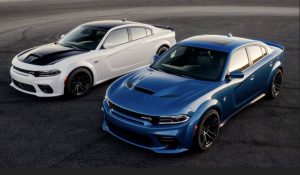
It also comes standard with a large V6 (rather than a turbocharged four) for under $30k to start. And you can buy one with a huge V8 for about the cost of a front-wheel-drive competitor equipped with its optional V6.
If it still offers the option.
Several no longer do.
Base price is $29,995 for the SXT trim with a 3.6 liter V6 paired with an eight-speed automatic and rear-wheel-drive. You can opt for all-wheel-drive (another rarity in the segment) for $33,595.
The 5.7 liter V8-equipped R/T stickers for $36,495 to start. It’s a rear-drive-only deal but that’s an option you can’t order for any sum in FWD-based sedans like the Toyota Avalon – which also costs several thousand dollars more to start than the Charger.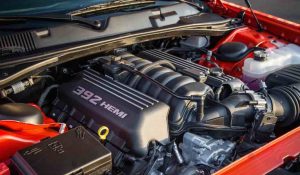
In fact, you can get into a V8 R/T Charger (which gets you more than just the V8) for only $620 more than the cost of the entry-level Avalon, which starts at $35,875.
A Charger GT has many of the R/T’s visual and chassis upgrades – but not the V8. You can get it for $31,995 with RWD and $34,995 with AWD – if you want bigger traction.
The $40,495 Scat Pack Charger comes with an even bigger (6.4 liter) V8. It’s also RWD-only. For bigger burnouts.
And if you like the idea of bigger fenders – and tires to go under them – there’s the Wide Body ($46,495).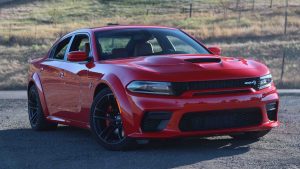
If you want bigger horsepower, Dodge has you covered there, too. The Charger Hellcat comes with a slightly smaller 6.2 liter V8 but with a supercharger to inflate its horsepower to 707.
The sticker for that is $69,995.
What’s New
In addition to the Wide Body option for the Scat Pack, a 50th Anniversary Daytona package is also available for the Hellcat (which comes standard with the Wide Body upgrades). The Daytona gets you another horsepower upgrade – to 717 – plus special leather seats, badging and a sure-to-be-collectible production run of just 501 copies.
What’s Good
That you can still buy it – literally. It’s not only still-available, it’s still affordable.
Standard V6, available V8s. Plural.
Huge trunk; passenger-friendly back seats.
What’s Not So Good
It’s the last of its kind you can still buy (excepting the Chrysler 300, which is a Charger sold by Chrysler).
No pistol grip shifter.
Small basic warranty – just three years/36,000 miles.
Unlike every car in its price range, all of which come standard with four cylinder engines and offer no more than V6 engines – the Charger comes standard with a 3.6 liter V6.
It makes 292 hp – with the option to upgrade to a 5.7 liter V8 that makes 370 hp . . . and the option to upgrade again to a 6.4 liter V8 that makes 485 horsepower.
And there are two more upgrades to go.
The Hellcat’s 6.2 liter V8 makes 707 hp; 717 if you opt for the Daytona package (while they last).
No one else offers this amount of power – and this number of options – for this amount of money.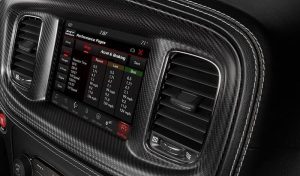
All of the Charger’s available engines are paired with an eight-speed automatic; V6-equipped Chargers come standard with rear-wheel-drive but you can opt for all-wheel-drive.
The V8 versions are all rear-wheel-drive.
Interestingly the big-engined Charger hasn’t got that big of an appetite relative to its smaller-engined (and smaller overall) rivals. The V6/RWD Charger carries an EPA rating of 19 city, 30 highway.This is only about 8 MPG less overall than the four-cylinder only (and only 192 hp) Honda Accord sedan’s 29 city, 35 highway.
And the Accord isn’t available with AWD, either.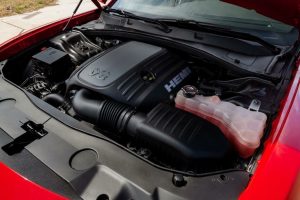
A Toyota Avalon – which comes standard with a 301 hp V6 – carries an EPA rating of 22 city, 31 highway, which is essentially the same mileage as the V6 Charger. But the Dodge stickers for almost $6k less to start than the Avalon, which makes up and then some for that 8 MPG difference.
The supercharged 6.2 liter V8 does have a big appetite – 12 city, 21 highway – but the astonishing thing is its appetite is almost the same as the 6.4 liter’s 15 city, 24 highway – despite the 222 horsepower difference in output.
The Hellcat also has the ability to get to 60 in less than 3 seconds. But the Scat Pack’d Charger is not far behind.
The Charger is a time machine. With four doors.
It takes you back to the ‘60s and ’70s – when almost every American car was rear-drive and large – without the ‘60s and ‘70s downsides of single digit fuel economy and double digit 0-60 acceleration.
Or the pop-on hubcaps popping off if you took corners at the speed limit.
Even though the cars of the Good Old Days did have big engines, most of them didn’t have big horsepower. The majority of them weren’t any quicker than today’s smaller-engined smaller cars.
They just used a lot more gas.
They did have that intangible but hugely appealing V8 throb, though. You could flip the air cleaner lid and hear the four barrel moan. You could hold the brake and let the rear tires rip.
And they had that road-trip heaven “big car” ride.
So does the Charger, only more so. Better body integrity, much better sound deadening and sealing quiet it down without slowing it down.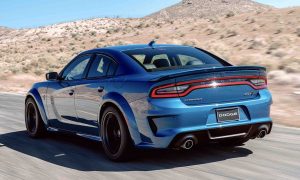
Plus, the hubcaps don’t pop off in the curves at 20 over the speed limit. There’s no four barrel carb but the burnouts you can do don’t require neutral-dropping the transmission or even power-braking the thing. Just let ‘er rip.
And then there is speed.
Armed with its available smallest V8, the Charger is one of the quickest fours doors on the road – then or now.
It’s not quite as quick as a V6 Camry or Avalon (they’re both much lighter) but the feel of its quickness is more authoritative. A .38 will kill a can of beans at 20 yards but a shotgun does it more pleasingly.
If upgraded to its bigger V8, it leaves the V6s sucking wind. Now you’re in the low fours – a real-world lesson in physics. About power overcoming weight. This version of the Charger is the quickest thing with four doors on the road . . . unless you pay twice or more as much as what Dodge asks for it.
And the sound of this one is priceless.
With its top-dog V8 (which comes with the unique sound of supercharger gear whine) there’s not much period that can keep up with it – including things with no doors at all, like superbikes.
And you can’t take four of your friends along for the three seconds to 60 ride.
This is a ballsy looking sedan.
Cops like it for a reason.
It’s an intimidating-looking sedan in Widebody configuration, with its massive pontoon fenders and lowered ride height.
All that’s missing is a three foot wing on the trunk – like the ’70 Charger Daytona had.
But the brash appearance hides a family friendly large sedan that makes a stronger argument for itself in that role because it is big and so has lots of room – something the smaller fry sedans haven’t got, in addition to not having anything big to offer under their hoods.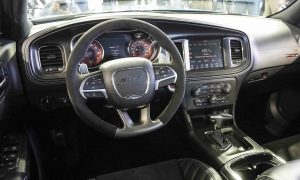
There is almost as much space in the back seat of the Charger (40.1 inches of legroom) as up front (41.8 inches) and the trunk (16.5 cubic feet) is as big as the trunk of a ‘70s land yacht.
These attributes make it a great choice for a family car that’s a lot more fun to drive than a typical family car.
Big is also inherently safe. Others tout “advanced” driver assistance technologies.This one touts steel. It is a car that can absorb a hit – with less damage – than the smaller/lighter cars in the same price range.
It’s built more like a truck than a modern car – which is just how American cars used to be built. They may have been gas hogs, but they also didn’t get totaled in what used to be low-speed fender benders.
Neither does the Charger.
It’s another reason why cops like it.
The only thing weak about this car is its standard three year/36,000 mile warranty coverage – which isn’t much better than American cars offered back in the ‘70s. But, the Charger’s physical toughness and the relative simplicity of its V6 and V8 engines – as opposed to the heavily turbocharged small fours common in the segment – are safe bets of a different sort.
The 2020 Charger is largely the same as the 2007 Charger, too – so we have a long-established track record to check out.
Which brings up a related point. Because it is old – design-wise – but new, odometer-wise – you can avoid many of the “advanced” safety assists and other annoyances that are making new cars insufferably naggy. The Charger doesn’t pester you with lights and buzzers . . . unless you want it to. 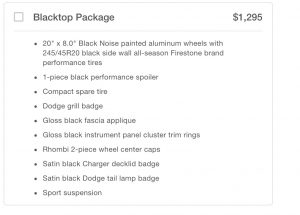
A Technology Package – with Advanced Brake Assist (the car applies the brakes, including when it’s not necessary) and Lane Departure Warning which harasses you with lights and noise if your tires touch a painted shoulder or yellow center line – is available. But you can skip it – and save yourself $1,895 as well as the nagging.
Almost every other car in the class comes with such “Advances” standard – which means you pay for it. Dodge lets you decide to not pay for it. Put the money in your pocket instead.
Or put it toward other things – like the Blacktop Package (available with the base SXT trim) which gets you 20×8 inch wheels with two-piece Rhombi center caps and 45-series tires, sport-tuned suspension, Nappa leather seats with heaters for both rows and a 276 watt amp with upgraded speakers – for $1,295.
And keep the change.
The Bottom Line
Living large is still possible – but who knows for how much longer. If the Hair Plugged Man defeats the Orange Man and the Green New Deal comes onine,
This may be your last chance to get the last of the Mohicans.
. . .
Got a question about cars, Libertarian politics – or anything else? Click on the “ask Eric” link and send ’em in!
If you like what you’ve found here please consider supporting EPautos.
We depend on you to keep the wheels turning!
Our donate button is here.
If you prefer not to use PayPal, our mailing address is:
EPautos
721 Hummingbird Lane SE
Copper Hill, VA 24079
PS: Get an EPautos magnet or sticker or coaster in return for a $20 or more one-time donation or a $10 or more monthly recurring donation. (Please be sure to tell us you want a magnet or sticker or coaster – and also, provide an address, so we know where to mail the thing!)
If you’d like an ear tag – custom made! – just ask and it will be delivered.
My latest eBook is also available for your favorite price – free! Click here. If that fails, email me at [email protected] and I will send you a copy directly!


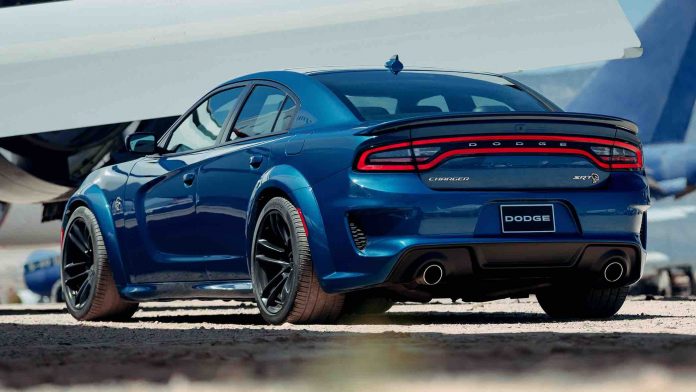

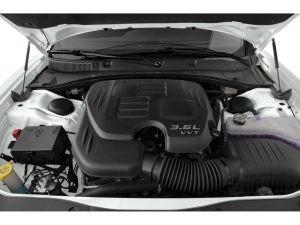
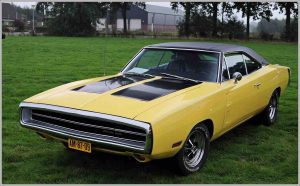

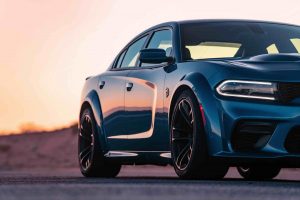
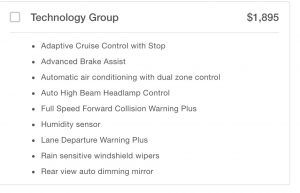







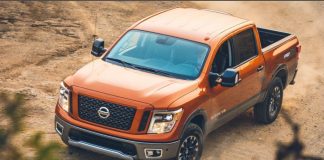
One of my former coworkers was in his Charger when a day-drunk woman in a Jeep Liberty ran a light and broadsided him.
He got pretty banged up, but if he was in his PT Cruiser, he would have been killed.
Actually the original Daytona was built in 1969. Great article.
Quite sad that the people interested in saaaaaaaaaaafety and tree hugging don’t understand why people want big cars in the US. Their idocracy just forced Americans into pickup trucks and big SUVs.
Sadly Chrysler corporation no longer exist and is just a part of the “high quality” French Peugeot and Italian Fiat conglomerate Stellantis.
I’ve been shopping for a used example. Something in sublime green which seems to be a unicorn so far lol. It seems they only made em in 07, and 17? I recently got back from a job overseas. One thing that caught my attention was these poor folks can’t have something like this without importing it and paying high taxes for the cubic inches. They only have vehicles at 2.0L or it gets unaffordable. Why drive like the 3rd world? We’re Americans!
5.7 Hemi beats V6 Camry’s and Avalons.the 3.6 Charger is right beside or hardly behind a V6 Camry!
4.9-5.2 0-60 and 13.30’s to 13.50’s in the 1/4 mile with the 5.7 Charger! Remember some tests show slower numbers because of 2.62 axle ratio’s you can get 2 other choices both lower for quicker times.
Traction or lack of it when floored,makes tests like the old days in the 60’s-early 70’s when they were laughable as cars were 2-4 seconds slower 0-60 and 1/4 mile! But newer cars hook better(wider tires,traction control)..My 392 hooks better than my stock 68 440 Charger RT!! Even I have 245/60/14 rear tires,better than the 215 wide tread bias ply tires it had when I bought it..it came with skinnier tires when new!!
I have 2.62’s in my 5.7 300S, no gear options with this cars. I think it clocks at around 5.5 0-60. Pretty awesome compared to the FWD crap sedans I have previously owned (many).
I love the car, love driving it. My only little complaint is with the 2.62’s when the cylinder deactivation thing kicks in it vibrates the car a little amount under light load, a little annoying. I do not witness this issue with my wife’s 2.90? geared Grand Cherokee V8 nor my new Ram 5.7 3.90 geared truck.
The good news is it has a ‘sport’ button that removes the cylinder deactivate thing and raises shift points. I am usually in the sport mode. Makes me feel like am in a ‘new’ muscle car (with pluses: that handles decent, rides good, is quiet and comfortable).
IF these cars are still around in 1-2 years I think I’m going to go Charger Scat Pack, only because of the better gears avail. and it’s the only way to get a limited slip (w/ the 6.4). My only issue is the Chargers look compared to the 300. While I like the Chargers looks, not so sure my older customers would?
I wished for a while that FCA would make another 300 SRT, then I would buy now.
I was doing research on Ram 1500’s with the 5.7 hemi, but got scared about the problems they were (are?) having with the cylinder deactivation. That deactivation is for squeezing mpg’s out of these trucks. Do the hemis in these cars have that “feature”? Curious. I am still skittish about that in the 5.7 hemis. (Ended up getting an F150 2.7L ecoboost)
Hi Tom,
Yes, the 5.7 V8 has cylinder deactivation; like ASS, it is designed to “save fuel” at the cost (to you) of additional parts/complexity and the possibility of higher repair costs. GM V8s also have this “feature,” though – so it’s hard to get avoid it without avoiding anything made since around the year 2005 or later.
The Chrysler system is supposedly more reliable now than previously but – I agree – the whole thing is creepy and we’d be better off without it.
Gents, I must admit, I had serious reservations about the V8 to V4 cylinder deactivation(CD) feature on my GMC 2019 4WD Yukon XL graphite package. But it has performed superbly. It’s gotten in the 30’s and 40’s in the highways. If I drive the speed limit, it averages up to 24-25 MPH on long trips. But with a 6.2L V8 (same as Corvette) and a 10 speed transmission(by Ford, thank goodness), it’s a virtual race car in disguise, as a jacked up station wagon. Can it fail? Sure, and if it does, well, a different cam and software update to run in a V8 mode constantly is the fix, about $1500 per my mechanic. The most I gotten MPG-wise in the V8 mode is 18, while in CD, 24-25. All told, about a 20-25% efficiency improvement in mileage. Again, it was used, and came with this option, so I figured the pretty hefty sum saved of about $20K for used vs new would justify the repair\replacement to full time V8 running for the CD failing down the road if it did. I also have a 2004 Ford 4WD Excursion with a V10, and that beast sucks gas like a top fuelie dragster, no CD for it! It gets 11 to 16 MPG, when I’m ginger on it, and much worse on vigorous driving. To each, their own, but I would consider it, at least, if the cost was not too high, on my next (if there ever will be one, lol) vehicle. The GMC gets 7-10 MPG better, on average, than the Ford, so you can guess which one we drive more.
Although the Avalon is similar in price, size and body configuration, I doubt that many of the same buyers are considering both the Dodge & the Toyota. I “might” consider both the Challenger and the Hyundai Stinger. But I’d probably end up with another Hemi. I’d buy the Scat Pack version , without the garish Wide Body option.
I love my 300S V8 RWD. It makes me happy when I drive it.
Another thing that made me happy was I was able to order it exactly as I wanted it, very rare today. Came in 4 weeks.
Long live the Charger/Challenger/300 triplets. Nice job FCA. Keep them going just the way they are.
Please bring back the 300 SRT8 and I’ll trade mine in for one. (basically same as the Charger Scat Pack).
I wonder if this type of car would still be the American norm if it hadn’t been for all the decades of monkeying with the market. Or would have car buyers tastes changed anyway?
Eric, have you seen what the corporate name of Chrysler-Fiat will be once the merger with PSA is completed? Stellantis. Who comes up with this stuff?
Is there a Challenger review forthcoming? Gotta love those two door sedans. I grew up driving a ’75 Mercury Montego two door: long hood, big doors. I know it was pretty much a Gran Torino, but I liked the looks of the Mercury. Too bad the rust got it…